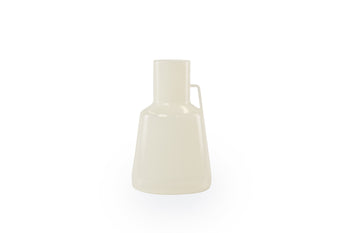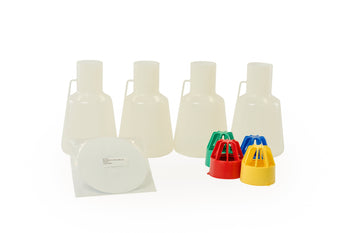
The TUNAIR™ Polypropylene Erlenmeyer Flask Systems
The TUNAIR™ Polypropylene Erlenmeyer Flask Systems are a unique and patented flask and closure system, specifically designed for microbiology and biotechnology applications. This system provides optimal growth conditions for aerobic microorganisms, mammalian cells, and plant cells. Compared to standard Erlenmeyer flasks, the TUNAIR™ system significantly enhances culture growth and productivity, making it an essential tool for research and industrial applications.
One of the key advantages of the TUNAIR™ system is its high oxygen absorption rate. This feature is achieved through a unique baffled flask design and a turbo-vane closure, both of which maximize the availability of dissolved oxygen within the culture medium. This design is particularly beneficial for applications requiring high oxygen transfer rates, such as microbial fermentation, cell culture expansion, and bioprocess optimization.
Enhanced Aeration and Mixing Efficiency
The TUNAIR™ Full-Baffle Shake Flask is engineered with six baffles that generate a propeller-like motion during shaking. This design significantly improves aeration and mixing efficiency, ensuring uniform distribution of nutrients and oxygen throughout the culture. The increased turbulence enhances mass transfer rates, leading to higher cell densities and improved metabolic activity. Unlike conventional Erlenmeyer flasks, which often suffer from limited oxygen transfer and uneven mixing, the baffled flask design ensures that microbial and cell cultures experience consistent aeration. This is particularly beneficial for organisms that require high oxygen levels, such as bacteria, yeast, and certain types of mammalian cells. The improved oxygen transfer and homogeneity in the culture environment result in superior growth kinetics and increased yields.
High-Quality Polypropylene Construction
The TUNAIR™ Erlenmeyer Flask Systems are constructed from durable polypropylene, a material known for its excellent chemical resistance and long-term stability. This ensures that the flasks can withstand exposure to a wide range of solvents and reagents commonly used in microbiology and biotechnology labs. The polypropylene construction also provides superior thermal stability, allowing the flasks to be used in temperature-controlled environments without degradation. Additionally, the polypropylene material is autoclavable, making sterilization simple and effective. This is crucial for maintaining aseptic conditions in sensitive biological experiments. The robustness of the material ensures that these flasks can be reused multiple times without compromising performance, making them a cost-effective choice for laboratories.
Optimized for Scalability and Reproducibility
One of the primary challenges in microbiological and biotechnological research is maintaining reproducibility across multiple experiments. The TUNAIR™ Polypropylene Erlenmeyer Flask Systems address this challenge by offering a standardized and optimized design that ensures consistent results. Whether used for small-scale research or large-scale bioprocess development, these flasks provide a reliable platform for cultivating microorganisms and cells with high reproducibility. The baffled flask design also makes scaling up cultures more efficient. Since the enhanced aeration and mixing properties are maintained across different flask sizes, researchers can confidently transition from small-scale experiments to larger production volumes without significant changes in culture conditions. This feature is particularly valuable for biopharmaceutical production, enzyme manufacturing, and other industrial applications where process consistency is critical.
Easy Cleaning and Maintenance
Cleaning and maintaining laboratory equipment are essential for ensuring the integrity of biological experiments. The TUNAIR™ Erlenmeyer Flask Systems are designed for easy cleaning and maintenance. The flasks can be cleaned by soaking them in water with a mild detergent solution to remove dirt and contaminants. After rinsing, they can be air-dried and stored for future use. Since the flasks are made from chemically resistant polypropylene, they do not absorb contaminants, ensuring that residues from previous experiments do not interfere with new cultures. This feature is particularly useful for laboratories that handle diverse microbial strains and require stringent cleaning protocols to prevent cross-contamination.
Applications in Microbiology and Biotechnology
The TUNAIR™ Erlenmeyer Flask Systems are ideal for a wide range of applications in microbiology and biotechnology. They are frequently used in microbial fermentation, where the baffled flask design enhances oxygen transfer, making them ideal for growing high-density bacterial and yeast cultures used in fermentation research and industrial bioprocessing. The increased aeration and mixing also support the growth of suspension-adapted mammalian and plant cells, making these flasks suitable for tissue engineering and plant biotechnology applications. Researchers working with recombinant protein production in microbial systems benefit from the optimized growth conditions provided by the baffled flask design. The improved oxygenation and mixing efficiency make these flasks an excellent choice for cultivating enzyme-producing microorganisms. Additionally, the ability to achieve high cell densities makes these flasks valuable for metabolic engineering experiments, where maximizing biomass is essential for testing new biosynthetic pathways.
TUNAIR Flasks by IBI
The TUNAIR™ Polypropylene Erlenmeyer Flask Systems offer an advanced alternative to standard Erlenmeyer flasks, providing superior oxygen transfer, improved culture growth, and enhanced reproducibility. The baffled flask design, combined with durable polypropylene construction, ensures optimal performance across a wide range of microbiological and biotechnological applications. By leveraging these innovative flasks, researchers and industry professionals can achieve more consistent results, improve productivity, and streamline their workflows in microbial and cell culture studies. Whether for academic research, industrial bioprocessing, or pharmaceutical development, the TUNAIR™ system is a reliable and efficient choice for high-performance culture growth.
- Accessories
- Specifications
- Technical Information
Flask Dimensions:
Flask Size: 300 ml
Working Volume: 100 ml
Base Diameter: 3.25” [8.25 cm]
Neck Diameter: 1.75” [4.45 cm]
Height: 6.00” [15.24 cm]
Height With Cap in Place = 7.25"
Weight: 0.01 lbs. [0.004 Kg]
Mixing:
Full-Baffle (6 Baffles): Propeller Motion
Shaker Speed:
1” Throws: 300-400 rpm or possibly higher
2” Throws: 150-200 rpm or possibly higher
Material:
All TUNAIR flasks and caps are constructed of chemical resistant polypropylene. All flasks and caps are fully autoclavable.
300 ml flask:
Allows for approx. 150 ml (max) of working volume for culturing cells
2.5 Liter flask:
Allows for approx. 1 liter (max) of working volume for culturing cells
Full-Baffle:
The bottom inside of the flask has 6 raised baffles. This configuration will generate 4 small propeller vortexes within the media inside the flask when fastened to an orbital shaker. The full-baffle configuration allows for slower operational rpm of the shaker while maintaining the vortexes within the media. The full-baffle flask is ideal for growing E.coli providing superior growth rates and cell densities.
Two Piece Cap:
The 300 ml flask and 2.5 L flask both have a special cap and filter system that promotes gas exchange and maintains sterility of the growth culture during use. The inner portion of the cap unsnaps from the outer portion by pushing in the tabs on the side of the cap assembly and then pulling the insert out.
0.2-micron filters:
There are two different types of 0.2-micron filters available for the TUNAIR flasks. These filters allow for maximum gas exchange while maintaining sterility.
Dri-Gauze – This is a paper filter than can be used approx. 6 to 8 times before having to be replaced. This filter can be autoclaved while in the cap, on the flask, for 6 to 8 times.
Silicone – This is a silicone filter that will last the life of the flask. This filter can be autoclaved while in the cap and on the flask for many times.
Cap & Filter Assembly:
Once you have the 2-piece cap assembly apart (either the 300 ml cap or the 2.5 L cap) place the corresponding filter size inside the cap and the re-assemble the inner and outer cap pieces making certain to align the tabs with their associated holes. Once clipped into place, make certain the filter completely covers the cap assembly openings.
Attaching the flasks to your shaker:
IBI TUNAIR flasks can be used with nearly all standard shakers and shaker clamps. The 2.5-liter flask typically fits best into the 2-liter shaker clamp. The 300 ml flask typically fits best in the 250 ml shaker clamp.
Preparing and Cleaning the TUNAIR flask:
Your TUNAIR flasks are constructed of polypropylene plastic which allows them to be autoclaved. Once you have prepared your media inside the flask you can place the cap & filter on the flask and insert into the autoclave. Set the autoclave for wet cycle.
Once you have harvested your cells, wash the TUNAIR flask in a mild dish soap such as Dove Dish Soap then rinse well with DI water. Do NOT rinse the Dri-Gauze filter between uses. The silicone filter can also be rinsed with DI water if needed. Observe the condition of the filters between runs to make certain there are no holes or tears in the filter. If there are, replace the filter immediately.
Cell Growth Evaluation of Commonly Used Shake Flasks:
TUNAIR™ flasks were compared to conventional flasks using four different types of microorganisms; Escherichia coli, Saccharomyces cerevisiae, Penicillium avellaneum, and Streptomyces chartreusis. The aeration capacities of the shake flasks were determined by the sulfate oxidation method, and the values shown below are presented as oxygen absorption rate (OAR) in mM oxygen/L/Min. The growth rates of E.coli and S.cerevisiae were expressed as optical densities (OD) at 555 mM. For S.chartreusis and P.avellaneum growth rates were evaluated by percent sedimentation. For E.coli and S.cerevisiae, the growth rates were determined after an 18-hour incubation period; for S.charteusis, a 24-hour incubation period; and for P.avellaneum, a 72-hour incubation period. Growth and OAR evaluations were carried out with 3-9 replicates and statistically analyzed using Turkey’s w-procedure. See results below.
Growth Chart:
| OAR Value | OD @ 555mM | % Sedimentation | |||
|---|---|---|---|---|---|
| Flask | mM O2/L/Min. | E.coli | S.cerevisiae | S.chartreusis | P.aveilaneum |
| TUNAIR™ Full-Baffle | 4.25 | 7.09 | 5.63 | 19.7 | 3.3 M |
| TUNAIR™ Half-Baffle | 1.22 | 5.36 | 5.57 | 27.73 | 30.50 P |
| Triple Indented Flasks | 2.47 | 5.97 | 5.31 | 19.20 | 9.50 MP |
| Unbaffled Erlenmeyer | 0.52 | 5.97 | 5.19 | 17.37 | 25.10 P |
Growth Morphology:
M, mycelial; P, pellet; MP, mixed mycelial. The mycelial growths mostly adhered to the walls of the flask, which accounted for the low overall sedimentation value.
Growth Comparison of Saccharomyces Cerevisiae in TUNAIR™ Shake Flasks and Brand C Shake Flasks:
The experiment was done on a New Brunswick INNOVA 44 shaker incubator.
It was conducted at different speeds – 200 rpm & 300 rpm.
Strain:Saccharomyces Cerevisiae
Medium: YPD broth (Yeast Extract Peptone Dextrose)
Flasks: IBI TUNAIR™ 300 ml Flask and Brand C 250 ml Growth Flasks
Cell Analyzer: Vi-Cell XR
S.Cervisiae Link: S.Cerevisiae Growth Chart
Experiment Abridgment:
In this experiment, standard volume--60 & 50 ml YPD--was used for TUNAIR™ and Brand C flasks, which is 20% capacity of the flasks. The flasks were incubated at 30°C at speeds of 200 rpm and 300 rpm for 28 hours. After taking viable cell counts, it was found that under low speed (200 rpm) both TUNAIR™ and Brand C flasks contained yeast cultures of higher cell densities when compared to the higher speed (300 rpm) cell culture flasks. It was also noted that the TUNAIR™ flask had higher cell density at 200 rpm and 300 rpm when compared to the Brand C flask. Although these data indicate TUNAIR™ flasks support higher density cell growth, we expected that higher speed (rpm) should produce higher cell density due to the higher dissolved oxygen concentration and better dispersion of cells. This unexpected data might be due to frozen cell culture stock, which might take a longer time to adapt to the environment.
More experiments are required and are being carried out at this time. The focus of these experiments will involve:
• Varying shaker speeds and varying volumes of medium in the TUNAIR™ and Brand C flasks
• Comparative studies between TUNAIR™ 2.5-L growth flasks and Brand C 2-L flasks
• Varying shaker speeds and varying volumes of medium in the larger TUNAIR (2.5 L) and larger Brand C (2 L) flasks
Reference Papers:
1. Method to Increase the Yield of Eukaryotic Membrane Protein Expression inSaccharomyces Cerevisiae
2. Optimisation of Recombinant Production of Active Human Cardiac SERCA2a ATPase












